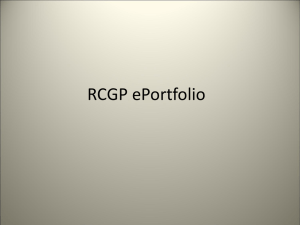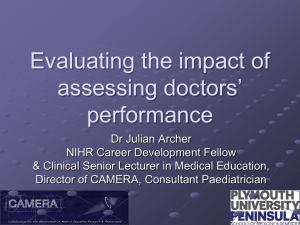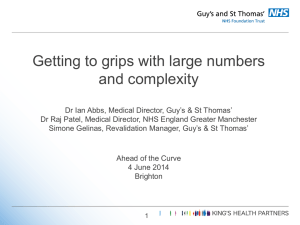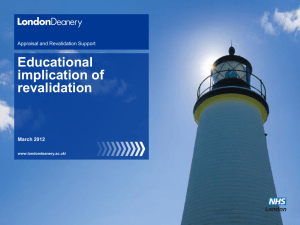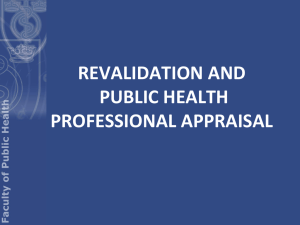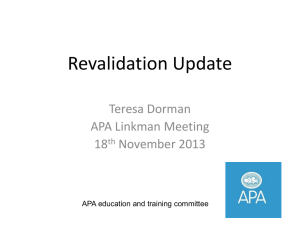Appraisal and revalidation
advertisement
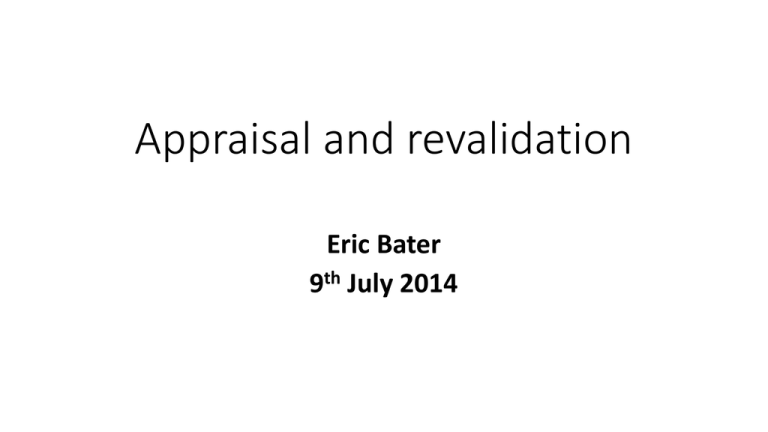
Appraisal and revalidation Eric Bater 9th July 2014 Revalidation:‘The means by which all doctors must demonstrate on a 5-yearly basis that they remain up to date and fit to practise’ The purpose of revalidation • To assure patients and public, employers and other health care professionals that licensed doctors are up to date and fit to practise The 2 elements GMC Revalidation: “Single-process” • Relicensure: license to practise on medical register (i.e. NHS doctor, prescribe & death certification) in accordance with the GMC’s generic standards [GMC driven] • Recertification (re-accreditation): certificate confirms doctors meet standards appropriate to be on GMC’s GP Register [RCGP driven] • Support: As a backstop, to identify for further investigation/remediation, doctors whose practice is/may be impaired One-Process Revalidation License to Practise 5-Yearly Relicence Certificate to be on the GP register 5-Yearly Recertification Why revalidation? • James Wisheart • Senior paediatric cardiac surgeon, Bristol • Struck off by GMC 1998 after failing to note excess mortality (29 deaths between 1988 &1995) Why revalidation? • Harold Shipman • GP in Hyde,Manchester • Convicted in 2001 of 15 murders of patients • Suspicion of involvement in 250+ deaths How would you prove a doctor was ‘up to date’ and ‘fit to practice’? ????????? Knowledge test /MCQ Taking the MRCGP Simulated surgery Masterpiece video Secret patients Self report Completion of postgrad education Annual appraisals (guided self reflection) Prescribing / referral data Patient satisfaction questionnaire Finally commenced 3rd December 2012 1) Annual appraisal 2) Portfolio of defined supporting information 3) Statement from responsible body of absence of performance issues Annual Appraisal Over 5-year period with local appraiser Responsible Officer Receives feedback on appraisal Responsible Officer Makes revalidation recommendation to GMC GMC: Doctor Revalidated Supporting Information: • Colleague & Patient Feedback • CPD records • Clinical Audit Medical Royal College / Faculty: • Define standards for appraisal & supporting information • Providing speciality guidance & advice for appraisers, appraisees and Responsible Officers Quality Assurance • Royal Colleges • System regulators (e.g. The Care Quality Commission) • GMC GMC ‘Good Medical Practice’ 2013 • Domain 1: Knowledge, skills and performance • Domain 2: Safety and quality • Domain 3: Communication, partnership and teamwork • Domain 4: Maintaining trust Domain 1: Knowledge, skills and performance •Develop and maintain your professional performance (para 7-13) •Apply knowledge and experience to practice (para 14-18) •Record your work clearly, accurately and legibly (para 19-21) Domain 2: Safety and quality •Contribute to and comply with systems to protect patients (para 2223) •Respond to risks to safety (para 2427) •Protect patients and colleagues from any risk posed by your health (para 28-30) Domain 3: Communication, partnership and teamwork •Communicate effectively (para 31-34) •Work collaboratively with colleagues to maintain or improve patient care (para 35-38) •Teaching, training, supporting and assessing (para 39-43) •Continuity and coordination of care (para 44-45) •Establish and maintain partnerships with patients (para 46-52) Domain 4: Maintaining trust •Show respect for patients (para 53-55) •Treat patients and colleagues fairly and without discrimination (para 56-64) •Act with honesty and integrity (para 65-80) Good Medical Practice: Domains and attributes Domain 1: Knowledge, skills and performance Domain 2: Safety and quality 1.1 Maintain your professional performance 1.2 Apply knowledge and experience to practice 1.3 Ensure that all documentation (including clinical records) formally recording your work is clear, accurate and legible 2.1 Contribute to and comply with systems to protect patients 2.2 Respond to risks to safety 2.3 Protect patients and colleagues from any risk posed by your health Domain 3: Communication, partnership and teamwork Domain 4: Maintaining trust 3.1 Communicate effectively 3.2 Work constructively with colleagues and delegate effectively 3.3www.revalidationsupport.nhs.uk Establish and maintain partnerships with patients 4.1 Show respect for patients 4.2 Treat patients and colleagues fairly and without discrimination 4.3 Act with honesty and integrity [14] Personal Development Plan RCGP Guide to the Revalidation of GPs. Jan 2010. version 3.0 Supporting information GMC ‘Supporting information for appraisal and revalidation’ 6 types of supporting information:1) Continuing professional development 2)Quality improvement activities 3) Significant events 4) Feedback from colleagues 5) Feedback from patients 6) Review of complaints and compliments RCGP – Supporting information for GPs • Review of completion of last year’s PDP • 50 credits/ year or exceptional circumstances statement • 10 SEAs in 5 years • 1 clinical audit or project in 5 years • 1 MSF with reflection in 5 years • 1 PSQ with reflection in 5 years • All complaints/ cause for concern, and compliments • Statements on probity, health and professional indemnity • Information to support extended roles Introducing…… The MAG form Knowledge, skills and performance ‘Maintain your professional performance’ Completion of last year’s PDP Case reviews Anonymised records Courses, conferences, seminars, with reflections Certificates of course attendance Knowledge, skills and performance ‘Apply knowledge and experience in practice’ Case histories Audit Prescribing data PUNs and DENs Examples of publications or teaching Knowledge,skills and performance ‘Ensure all documentation formally recording your work is clear,accurate and legible’ Anonymised case records Samples of letters The appraisal document itself Examples of material used for presentations Safety and quality ‘Contribute to and comply with systems to protect patients. Significant events Personal involvement in quality improvement programmes Mandatory training (safeguarding,BLS) Examples of ‘whistle-blowing’ Safety and quality ‘Responds to risks to safety’ Handover systems and policies Communication of test results Health and safety, and manual handling Personal immunisation record Significant events Communication, partnership,teamwork ‘Communicate effectively’ Evidence of practice development activity (e.g patient pathways) Reflections on role in the team Myers Briggs personality inventory Belbin profile, and reflections Communicating, partnership, teamwork ‘Work constructively with colleagues,and delegate effectively’ Teaching for students or colleagues Multi-source feedback Communicating, partnership, teamwork ‘Establish and maintain partnership with patients’ Patient surveys Letters from patients or relatives Information and reflection on patient participation groups Maintaining trust ‘Show respect to patients’ Chaperone policy Knowledge of information governance Managing requests from patients Maintaining trust ‘Treat patients and colleagues fairly and without discrimination’ Complaints Management and leadership activities Feedback and learning from research Maintaining trust ‘Act with honesty and integrity’ Declaration of any interest in pharmaceutical companies Managing of finances Protocol for dealing with gifts MDU /GMC membership Supporting Information for Annual Appraisal This Checklist must be submitted with the MAG Form Date of Appraisal Appraisee Name and Birth month Appraisee GMC number Apprais ee RO Revalid Date Appraiser Name CNTWear or DD Tees Basic Supporting information required for appraisal Frequency Quality Improvement Activity – Evidence of a review and evaluation of your clinical work, with learning and action points. This can include full cycle audits, smaller scale condition based or practice system reviews , follow up of referrals , random case analysis, or challenging case reviews etc Once every 5 years for a full auditAND /OR smaller activities on an annual basis Every year Log or diary of educational activities throughout including reflections, with estimated number of CPD Credits Credits SEAs (2 each year) –review of any situation where care was sub-optimal and could have been better, or where care was exemplary —written up using a template including reflection–discussed with PHCT/ learning group or colleague. Two Challenging cases are an alternative if no SEAs Review of any complaints-all formal complaints must be discussed, reviewed and learning and actions identified Every year Colleague and patient survey – approved tools include One every 5 years Patient survey Colleague survey Every year Edgecumbe http://www.edgecumbehealth.co.uk/ CFEP Surveys http://www.cfepsurveys.co.uk/products/general-practice/ Clarity and RCGP also acceptable , both use GMC questionnaires Review of all roles undertaken as a doctor –additional clinical roles, CCG work ,teaching, training, sports medicine, management, research, appraisal, OOH.etc Please identify any roles NOT reviewed *Certificate of CPR training Appraiser GMC number Every year 18 months Seen Comments 1.Clinical Audit report Title of Audit Date of Audit Who was involved in the audit? (List of people including designation) Background (This should include a brief description of the reason for selecting the topic) Aim of the Audit (This should identify what you need the audit to tell you e.g. is current practice compliant with a particular piece of guidance i.e. NICE guidance/local PCO policy etc ) Criteria (This section identifies the aspects of care which you are going to measure and should be clearly defined) Preparation and planning (How you intend to carry out the audit e.g. records search) Initial standard setting (What are you aiming for 100% , 90% etc ) Analysis and Findings (This section should outline the level of compliance achieved against the audit standard and if full compliance not achieved an explanation of why. What was learnt from the data collection? ) Conclusions and reflections from the first cycle of the audit (What changes are needed to meet the standards set in this audit? How will the changes be implemented and who will do this and when? How was this communicated to the team if appropriate? When will the re-audit occur?) Re-audit findings (The re-audit report should include the date of second data collection, the Standard achieved and whether further action is required) Reflection on other Quality Improvement Activities Description of the activity - eg review of telephone triage from OOH, review of referrals or prescribing or small scale quality improvement activities that are not full audit cycles Why did you pick this TOPIC/ DATA SET case (eg to reflect on your practice and identify learning needs, to demonstrate application of learning, to identify areas for improvement –SEA, other) Are there any external bench marks/standards against which you can compare your activity/ performance in this area? What have you learnt from this activity? For yourself For the practice [if appropriate] What changes or actions have arisen from review of this activity? . For yourself For the practice [if appropriate] Have you reviewed these changes yet –if not when/how will you do so? Significant Event Report Significant Event Analysis - Title: Date of incident: Date of meeting when event was discussed – this can be in your practice or in a self-directed learning group. Description of event - what actually happened and what was your direct involvement in the event? What went well? And what could have been done better? What were the learning outcomes? For yourself For the practice [if appropriate] What changes have been agreed? This should clearly identify who is responsible for each action and a date that the action is to be completed. The initials and job title can be used to maintain confidentiality. For yourself For the practice [if appropriate] How and when will the effect of these changes be reviewed? Case review Description of the clinical event–this may be a personally challenging case or a complex diagnosis Why did you pick this case (eg to reflect on your practice and identify learning needs, to demonstrate application of learning, to identify areas for improvement –SEA, other) What went well? And what could have been done better? What was the root causes of the incident? What learning needs have arisen from this case? For yourself For the practice [if appropriate] [if you have not had the opportunity to discuss the case in depth this can be done in the appraisal meeting] What changes or actions have arisen from review of this case? . For yourself For the practice [if appropriate] Have you reviewed these changes yet –if not when/how will you do so? Complaint Report Date of complaint: DESCRIPTION of complaint: What actions were taken to investigate and resolve the complaint? Involvement of other bodies: eg PCSA / SHA / NCAA / GMC / Medical defence organisation, Other Status of complaint: On-going / resolved: If on-going-what are current actions? If resolved, what were the findings? Was the complaint discussed : -within the PHC Team? With a colleague? With a learning group? With anyone else? How will my practice change? Templates for reflection on Patient and Colleague feedback Name of doctor: Date of patient survey: Which survey tool did you use –CFEP/Edgecumbe/Clarity/RCGP What issues did you identify from the exercise? Hints: Look at your positive findings just as carefully as the most negative. Compare your self assessment with that of your patients is it similar or quite different –why might that be? What actions might you undertake as a result of the survey results? Hints: These might include: improving communication techniques, restructuring, negotiating changes to the consulting environment, developing skills with respect to specific cohorts of patients, learning more about how to learn from patient surveys Name of doctor: Date of colleague survey: Which survey tool did you use –CFEP/Edgecumbe/Clarity/RCGP What issues did you identify from the exercise? Hints: Look at your positive findings just as carefully as the most negative. Compare your self assessment with that of your colleagues is it similar or quite different –why might that be? Discuss and seek advice from colleagues both peer and senior, if possible. If you have difficulty identifying learning needs from the survey, be frank about this. Skills in interpreting such information can then be considered as your first learning need in this regard. What actions might you undertake as a result of the survey results? Hints: These might include: improving communication techniques, restructuring, improving teamwork/leadership skills, learning more about how to learn from colleague surveys (as above). Learning Diary Learning Events and activities Duration/TI CPD credits Date Title ME claimed Topics Reflections covered Further actions What about revalidation of doctors in training? GMC ‘Information for doctors in training’ www.gmc-uk.org/reval4trainees ‘The responsible officer will make a revalidation recommendation based on participation in the ARCP process’ What is a ‘responsible officer’ •Dr Mike Prentice (HENE LETB) When will you revalidate? CCT First revalidation • Between 1st April 2014 & 31st March 2018 • After 31st March 2018, and those trainees who do not currently have a CCT date • At point of eligibility for CCT • Between 1st April 2016 and 31st March 2018 Appraisal for ST3s See HENE website ‘A brief appraisal guide for ST3 GPRs’ Aim is for all ST3s to have experienced an appraisal and formed a PDP Evidence come from e-portfolio Appraisal done using MAG form Appraiser will be trainer, or other trained appraiser in the practice Introducing the MAG form www.revalidationsupport.nhs.uk/CubeCore/.u ploads/documents/pdf/MAGmodelappraisalf ormv3.pdf MAG form sections 4) Roles as a doctor 6) PDP from last year 7) CPD 8) Quality improvement activities 9) SEAs (don’t upload) 10) Complaints (leave blank) 12) Challenges and aspirations 15) Proposed PDP 17) Reflections on domains of ‘Good Medical Practice’ Future appraisals related to birth month (617 months from ST3 appraisal) Next revalidation 5 years after leaving VTS unless prolonged absence (>2 years) from practice Other possible formats:RCGP revalidation e-portfolio Clarity website
